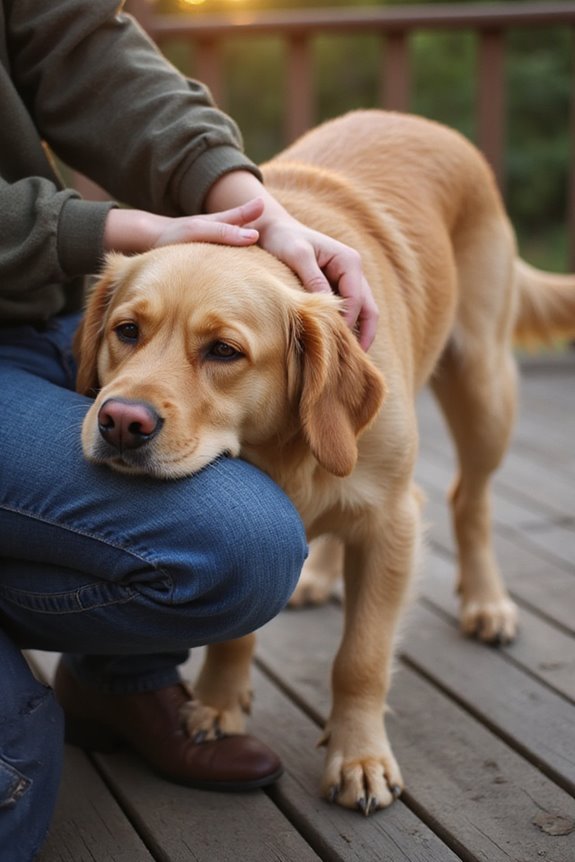Dogs show affection through various behaviors, including:
- Tail Wagging: Right wags indicate happiness; slow wags suggest insecurity.
- Eye Contact: Mutual gaze increases oxytocin levels, enhancing emotional bonding.
- Physical Touch: Lying close and body leaning reveal trust and attachment.
- Licking: This instinctual act fosters emotional connections.
- Greetings: Vocalizations like gentle barks signal friendliness.
These behaviors provide insight into their feelings. Understanding these signals can strengthen your bond with your dog. More details await.
Key Takeaways
- Dogs wag their tails, especially right wags, as a sign of happiness and affection.
- Engaging in eye contact increases oxytocin levels, enhancing emotional bonding and trust.
- Lying beside their owners indicates comfort and trust, strengthening the connection.
- Affectionate licking and relaxed mouth expressions signify love and emotional connection.
- Greeting behaviors such as higher posture and gentle vocalizations express friendliness and social bonding.
Tail Wagging and Body Language
Understanding how dogs communicate through tail wagging and body language is essential for interpreting their emotional states accurately. The direction and speed of a dog’s tail can reveal significant insights.
- Tail Wagging Direction:
- Right wags indicate happiness or confidence.
- Left wags often correlate with fear or anxiety.
- Tail Height and Speed:
- Fast wagging at mid-height usually denotes friendliness.
- Slow wags with a low-held tail suggest insecurity.
- Contextual Interpretation:
- Wagging combined with relaxed body posture shows affection.
- Tense positions with wagging may indicate excitement mixed with anxiety.
Eye Contact and Oxytocin Release

While tail wagging and body language reveal many emotional cues in dogs, eye contact serves as a powerful form of communication that greatly enhances the bond between dogs and their owners. When we share a gaze with our dogs, it triggers an oxytocin release—often referred to as the “love hormone.” This mutual gaze behavior considerably boosts oxytocin levels, with studies showing a remarkable 300% increase in owners and a 130% increase in dogs. Engaging in this eye contact establishes a positive feedback loop, fostering emotional trust and social bonding between us. By understanding the importance of gaze in dog-human interaction, we can deepen our connection, ensuring our beloved companions feel secure and cherished.
Physical Touch and Proximity

Physical touch and proximity are essential components of how dogs express their affection towards humans. When my dog chooses to lie beside me, it reflects trust and comfort. Some dogs, due to their cuddling preferences, may snuggle in my lap or prefer staying close. I notice body leaning as a gentle yet meaningful sign of attachment; when my dog leans against me, it releases calming endorphins for both of us. Petting response also plays a significant role—knowing the areas they enjoy being touched enhances our bond. However, I’ve learned that many dogs dislike avoidance touch, such as excessive restraint, which can induce stress. Respecting their boundaries fosters a deeper, affectionate connection between us.
Licking and Mouth Expressions

Licking and mouth expressions are essential ways dogs communicate their affection and emotions, enriching their bond with humans.
- Instinctual Behavior: Licking is an instinct, fundamental for grooming and emotional connection. Mother dogs lick their puppies, fostering comfort and cleanliness, which influences their affectionate licking behavior toward humans.
- Affectionate Actions: This licking behavior releases calming neurochemicals, promoting relaxation and joy. It’s a direct expression of love and social bonding between us and our furry friends.
- Mouth Communication: Dogs also use various mouth expressions, like gentle licking and relaxed lips, to convey their feelings. These mouth communications can indicate friendliness, submission, or even a playful attitude, enhancing our understanding of their emotions.
Recognizing these signs deepens our connection with our dogs.
Greeting Behaviors and Vocalizations

Greeting behaviors and vocalizations serve as essential components in how dogs engage with one another and with humans. During greetings, dogs typically maintain a higher posture, and the greeting duration averages around 6 seconds. Importantly, olfactory inspection plays a vital role; dogs often sniff specific body regions like the face or anogenital area, providing essential social information. This phase usually lasts only about 3 seconds, emphasizing its efficiency. Vocalizations, such as gentle barks or high-pitched sounds, further enhance these interactions, signaling friendliness and inviting exploration. These brief yet significant greetings foster a sense of comfort and social engagement, reinforcing positive connections within the canine community while ensuring their interactions remain non-threatening and friendly.
Facial Expressions and Ear Position
Understanding how dogs communicate through facial expressions and ear positions is essential for interpreting their affection. Dogs use various facial cues, such as the well-known “puppy dog eyes,” to express longing, while a relaxed smile signifies happiness and playfulness. Their ear signals, too, play a significant role; soft, relaxed ears suggest contentment, whereas ears held sideways indicate friendly interest.
Key indicators include:
- Facial Cues: Relaxed eyes and slightly open mouths indicate comfort.
- Ear Positions: Neutral or slightly back ears signal trust and affection.
These nonverbal cues highlight dogs’ ability to connect emotionally with us, showcasing their evolved capacity for deep social bonding through facial expressions and ear positions.
Understanding Context in Dog Affection
When evaluating how dogs express affection, context plays an essential role in interpreting their behaviors accurately. Understanding affection signs requires scrutiny of emotional context. For instance:
- Tail Wags: A moderately wagging tail typically indicates happiness, while a “helicopter tail” reveals excitement. However, a tucked tail may signal fear.
- Physical Contact: Dogs may nuzzle or lean against you, exemplifying trust. Preferences for physical touches can vary.
- Vocalizations: Soft whines or contented sighs often indicate affection, but context matters; enthusiastic barking highlights joy.
- Proximity: Leaning into you or staying close reflects attachment and a desire for bonding.
Frequently Asked Questions
Do All Dogs Show Affection the Same Way?
Did you know that 70% of dogs express affection through unique body language? I’ve witnessed the power of vocal expressions as each fur companion shows love in their own heartwarming way, deepening our bond every moment.
Can Dog Breeds Affect How They Express Affection?
Absolutely, dog breeds really do affect how they express affection. I’ve observed breed-specific behaviors and affection variations; some are cuddly, while others prefer playful interactions, reminding me how unique each connection with our furry friends can be.
How Do Puppies Show Affection Differently Than Adult Dogs?
I’ve noticed puppy behavior often bursts with energy, while adult bonding feels more subdued. Puppies jump, nip, and seek constant attention, showing affection in playful chaos, while adult dogs express love through calm, touching connections.
What Should I Do if My Dog Doesn’t Show Affection?
Did you know that 40% of dogs struggle with showing affection? Understanding dog behavior really helps. I’d encourage patience, gentle interaction, and creating a safe space, fostering the intimacy both you and your pup deserve.
Are There Signs of Affection That Indicate a Dog Is Stressed?
I’ve noticed that when my dog displays certain body language—like a tucked tail or pinned ears—it’s often stress signals, not affection. Understanding these cues helps me respond better to their needs and create a safer space.


